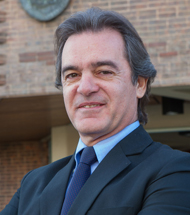"Litter is also a problem in space".
Osvaldo Peinado, Head of Ground Operations of the German Aerospace Center, guest at the Albareda Lessons of the Chair Timac Agro-University of Navarra

PHOTO: Manuel Castells
"Around the Earth there are already a million objects over 1 cm in diameter that are considered junk and are flying at thousands of kilometers per hour. And many more of smaller size that are not counted but pose a real problem, since no country wants to pay the price of sending a robot to pick them up, and that garbage can collide with our satellites, with the International Space Station, etc., as has already happened, causing serious damage and with a high economic cost".
This was explained by Osvaldo Peinado, Head of Ground Operations at the German Aerospace Center, at framework of the third Albareda Lecture, a series of conferences promoted by the Chair Timac Agro-University of Navarra with the goal to bring top level scientists to campus .
According to this expert - who has headed the Satellite section of the German aerospace agency since 2015 - "although a law was passed to force satellites sent into space to retain enough fuel to be able to return to Earth once they stop working, many small satellites do not have that possibility and are left floating in space. In the case of geostations (for television, etc.), they have a built-in motor that takes them out into outer space, since the Earth's magnetic field is limited and there are already space problems to place all the satellites that are currently operating," explained the expert, who holds a doctorate in Space Sciences from the University of Munich.
Remote control systems in agricultureDuring his exhibition in the Albareda Lectures, in the School of Sciences of the University of Navarra, this Argentine computer engineer detailed the types of remote detection systems using radar, laser technology, airplanes or drones "that are also increasingly used in agriculture to determine the state of a crop, whether or not there is enough water, etc. Radar, for example, even makes it possible to see what is under the surface of the earth, and thanks to it, ancient cities have been detected under the sands of the Sahara desert".
The second part of his lecture focused on the work that, for 12 years, he carried out as coordinator in Europe of all the space missions that were sent between 2003 and 2015, as well as the training and supervision of the astronauts who participated in them. "In my work I was even called in the wee hours of the morning from Houston to tell me "Osvaldo, we have a problem" on occasions when any event happened on the International Space Station (ISS) that could endanger the lives of the astronauts or any of the very expensive experiments they develop there." "In these cases," he stressed, "you have to coordinate the work of more than 800 people and it is essential that you can make decisions without getting nervous, without losing your cool, and immediately."
Regarding the possibility of sending permanent expeditions to Mars - the planet that is emerging as an alternative home to Earth - Peinado confirmed that the technology to make such expeditions a reality has been available for some time: "If they have not been done yet, it is only for economic reasons. It is very expensive to take a person into space. In fact, it is much cheaper to send a robot, that is why several expeditions with them to the Moon are planned for next year", concluded the guest of the Chair Tima Agro-University of Navarra.
